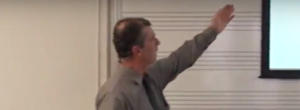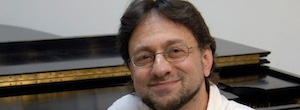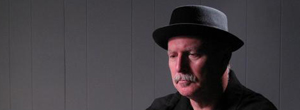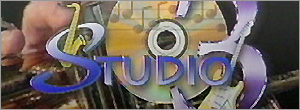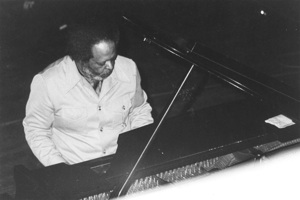
"Young Jaki", by Chet Williamson
He was a child of destiny. As a kid growing up in Worcester, Jaki Byard was surrounded by music and he took to it like a fish—swimmingly.
According to his birth certificate, he was born John Arthur Byard, Jr., on June 15, 1922. At the time, his parents were living at 47 Clayton Street, smack dab in the heart of city's African-American neighborhood. The family also later lived on Rodney and Carroll streets.
In the Worcester Directory, his father is listed as a chauffeur. That was his day gig. He was first and foremost a musician. (Genealogy.com reports that he was the son of William H. Byard and Jessie Martin, and was born September 2, 1897 in Truro, Nova Scotia. He died at the family homestead in Oak Bluffs, MA in 1968.) John, Sr. was a brass player who worked in local marching bands and was part of the African-American movement that sprung up during the Civil War's reconstruction.
In an interview with Sonja Williams for National Public Radio (NPR), Jaki said, "My father played bass horn, trumpet. As a matter of fact, that's how I learned to play. He showed me how to finger the trumpet."
John, Sr., was also very active in Worcester's burgeoning jazz scene, which at the time was just coming into focus as the "new" music. John Sr. worked with the premier jazz bands of the day. In the early 1920s, he was a member of the very first professional jazz ensemble in Worcester, Mamie Moffit and Her Five Jazz Hounds. In the late '20s, when the group was taken over by drummer Boots Ward and became the Nite Hawks, John Sr. was still among its ranks.
In 1921, John Sr. married Geraldine M. Garr, Jaki's mother. Geraldine was born in Norwich, CT in 1899. She was the daughter of Craig Garr and Malvina Hannibal, a pianist who played for silent films. (Malvina 1878–58 was the daughter of Ebenezer Hannibal and Mary Johnson.) In its biographical sketch of Jaki, the New England Conservatory noted this about Malvina: "As silent picture shows were replaced with the technological advances of the 'talkies,' or movies with their own sound, her job grew obsolete and she was able to bring the piano from the silent movie house to their home."
"My grandmother used to play," Jaki told NPR. "She used to play for the movie houses. That's how we got the piano, because after the [silent] movie industry folded up, they gave her the piano. And my grandmother gave my mother the piano. They put the piano in my house and that's how I got started."
Jaki's mother Geraldine was listed in the Worcester Directory as a candy maker, but more importantly she was also a pianist, who played for the A.M.E. (African Methodist Episcopal) Zion Church. Jaki told producer Sonja Williams that he began playing the piano at home. And, according information in a calendar produced by the Prospect House (a now-defunct inner-city social service center), he started taking formal lessons at the age of 5 (to age 8) with piano teacher Grace Johnson Brown in her George Street home.
Jaki was a graduate of Elizabeth Street School and later attended Commerce High School. Although he is listed as being in the school band, no class picture of Byard appears in his yearbook. His graduation was interrupted and postponed until after military service. According to the Prospect House, during his teen years, Jaki's father suffered a series of strokes. Each time, the good son would leave school to work his father's job until John Sr., could return to work. Jaki says his mother was a supportive woman who shared her love of music with all of her children (two sons – John Jr., and William, and a daughter Jesse).
"My mother used to give me seventy-five cents to go see the bands that were playing at Quinsigamond Lake—ten cents for the streetcar each way, fifty cents to get into the dance, five cents for a Coke," he told writer Royal Stokes. "I would walk to the dance so that I could drink five cokes. I'd stand in front of the band all night and listen -- Fats Waller, Lucky Millinder, Chick Webb with Ella Fitzgerald, the Benny Goodman Quartet with Teddy Wilson, Lionel Hampton, and Gene Krupa. That would be about 1936."
Jaki told NPR that his favorite bands were those led by Earl Hines, Jimmie Lunceford, and Count Basie. "Of course there was Stan Kenton, Woody Herman and that crew," he said. "Teddy Wilson was a favorite too. He was with Benny Goodman. My father used to listen to him every night.
"He'd say, 'Come here and listen to this man. Do you know who he is?' 'Yeah, I know who he is.' 'Do you know what he is?' I'd say, 'What?' He'd say, 'He's us—he's a colored boy.' He didn't say ‘black’ then."
Growing up in Worcester in the 1920s was a time of both turbulence and promise for people of color, and the contradictions ran deep. During the Civil War antebellum-era, Worcester was a major stop on the Underground Railroad. After the war, things changed. By the 1920s, while cyclist Major Taylor (known as the Worcester Whirlwind), was winning world championships, it was also a city that held huge Klu Klux Klan rallies.
The Byards lived in what was known as the Laurel/Clayton neighborhood, named after those two streets intersecting at its heart. In the area’s heyday, it was the hub of black life in Worcester. In addition to being the abode of Jaki Byard, such future national stars as Wendell and Zara Culley also resided there. (Zara,a graduate of the Worcester School of Speech and Music, was a character actress. best known as George Jefferson's mother in the hit CBS show, The Jeffersons. Wendell was a trumpeter with Noble Sissle, Cab Calloway, Lionel Hampton, and Count Basie, and the author of such classic jazz solos as that in "Lil' Darlin'.) The neighborhood was also home to such local legends as Howie Jefferson, Barney Price, and Reggie Walley, among others.
In the late 1950s, before the "Worcester Expressway" (I-290) cut through its center, the Laurel/Clayton neighborhood was a rectangular-shaped enclave that stretched from Belmont Street at the north to Union Station, south. To the east it covered the hill up to Eastern Ave. To the west, down to what is now Martin Luther King Boulevard.
Summer Street was its central artery. And before the Plumley Village Housing Project was built in 1971, the street was home to a city jail, churches, schools and civic centers, as well as package stores, barbershops, markets, restaurants and numerous nightclubs (the Nile Café, Silver Dollar Café, the DuNord Hotel, the Valhalla, the Somerset Hotel). At its peak in the 1940s, Laurel/Clayton was a thriving little community fondly recalled in the memories of those who lived there—as evidenced in the annual reunions held in Worcester every summer.
By all accounts, Jaki also thrived in this environment. According to Leonard Feather’s Encyclopedia of Jazz, he secured his first musical engagements through the Worcester Boys Club as a young teen. At 15, he played his first professional music jobs out of town. "One of my first gigs was in Grafton with a guy named Doc Kentross (dentist)," Byard told Worcester Magazine. "The day I made the gig I came running out of the high school and fell on my hand. I had to get six stitches and played that night."
A year later, at 16, he began supplying Freddie Bates and the Nite Hawks with arrangements for their songbook. Jaki was also sitting in with the band, along with his father, on trumpet and piano. One of the Nite Hawks’ regular dates at the time was at the Nile Café on Summer Street, which was reported to be the only local jazz venue owned and operated by African-Americans.
In the Worcester Magazine interview, Byard said, "There was a guy named Pete Price (pianist). I took his place. I was about 18 years old. We used to play up in Holyoke, Springfield … on the road."
It should be noted that 1922 is also the birth year of such jazz musicians as Charles Mingus, Duke Jordan, Illinois Jacquet, Oscar Pettiford, King Pleasure, and Mundell Lowe. Byard's generation of notable Worcester players includes: Emil Haddad (b. 1922), Barbara Carroll (1925), Don Asher (1926), Don Fagerquist (1927), and Harry Sheppard (1928)—all on record saying they were affected by Byard's presence.
Pianist and novelist Don Asher grew up in Worcester. He played his first gig at the Sundome Café on Harding Street. His pay for the night was $1.50. In describing the club scene in Worcester of the 1930s, he writes:
"To my last breath I will marvel at the number of—I hesitate to call them clubs—taverns, joints, converted stores, renovated barns, gutbuckets, subterranean holes-in-the-wall (saloons was the kindest word our parents used, garbage dumps and cathouses the most disparaging) that prevailed in and around Worcester during the two decades spanning World War II.
"To our dismayed parents these dilapidated havens where my musician classmates and I served our teenage apprenticeship in Spartan horn–piano–drums trios were virtual sewers in terms of fragrance and the class of inhabitants, catacombs of depravity peopled by lowlifes: besotted men with hacking coughs and gray pallor, and brazen women with blotched skins and reputations who wore slinky dresses and drank like deckhands. Our parents' visions may have been slightly feverish, but no less heated were our own imaginations, which effortlessly transformed these reeking, smoke-filled dens into storybook honky-tonks, replicas of the fabled river-town saloons, gangster-run speakeasies (offering bootleg gin and whores in silk dresses along with the music) and funky-butt brothel parlors that were the mythical cradles of jazz; we were drawn to them as leeches to a bruise, babes to the breast."
Asher, who was a student of Byard, left Worcester in 1959 and settled in San Francisco. He is a winner of the ASCAP—Deems Taylor Award for Raise Up Off Me: A Portrait of Hampton Hawes. In the opening chapter to his book Notes from a Battered Grand, he writes about the first encounter with his teacher.
"A musician I looked up to, "Duke" Goldman, lived across the street. He was two years older and was working weekend nights at a brawling basement grotto called the Bucket of Blood (didn't every northeastern mill town in the '40s have one?). 'There's a piano player in the joint across the street you won't believe, sounds almost like Tatum. Colored guy.'
"On a sweltering Saturday night in June I caught a bus to Duke's place of business … I saw the gory neon sign Bucket of Blood across the street, but it would take me the better part of the evening to reach it. I was passing an even more unassuming establishment – "Dominic's Café" painted on insect-caked glass backed by ratty-looking bamboo blinds—[and] the door opened to the humid night.
"And what poured out that door was as wide and surging as a swollen river. A skinny white drummer and the colored piano player Duke had spoken of: a big heavy-shouldered fellow in a blue shirt and brown pants. His eyes seemed remote glistened with ardor and tension.
"But the sound … it was jubilant, cocky, it leaped and shouted. I can't say how long I stood in the doorway more inside than out, oblivious to the shadowy, questioning faces, washed by echoes of all the music I had ever read about—the Harlem house-rent parties (where legend had it the players could devour a pig's foot or swig from a bottle of beer while the left hand alone pumped both melody and rhythm), the strut of Southland cakewalks and brass band parades, and endless, linked choruses of pile-driving boogie-woogie that went lickety-split like a night train slamming across prairie tracks.
"Heads were snapping and fingers popping on the little patch of dance floor, the piano player's galloping stride springing off walls and bodies and needing no support, drums merely aboard for the ride like a kid hanging piggyback on the massive blue-shirted shoulders, a weightless toy train hitched to a life-size diesel.
"The little room seemed ready to explode, hardly able to contain the cadences pouring out the doorway and into the street, engulfing me in waves of vibration that set my scalp tingling and tripped a wild,
grainy current down my backbone. When the set was over I edged my way through the jostling crowd, honing in on the blue shirt and sweating dark face, as single-minded and needful as a hungry pup sniffing a backyard barbecue."
Asher also writes that it must have been near midnight when he finally crossed the street to the Bucket of Blood where his friend was playing.
Seeing Asher, Duke quipped: "You should have come earlier; we only have one more short set. You can ride home with us, except we usually stop to catch the guy across the street; he goes to twelve-thirty."
"I already have."
"What'd you think?"
I opened my mouth to answer and ended up fluttering my fingers.
"Didn't I tell you? Guess how old he is?"
"Twenty-five, thirty?"
"He's a senior at Commerce High. His name's Jackie [sic] Byard."
"I know. I'm going to be studying with him."
As Asher mentioned, Byard went to Commerce High School. Located on Walnut Street, across Main Street, just up the hill from Mechanics Hall; the school was two blocks west of the neighborhood.
While attending Commerce, Byard studied music, "right up to Harmony IV," he said. "John Wilson senior and junior were his teachers. "They played, too," Byard added. "Worcester was pretty nice for music at that time." (according to Robert Bliss in the Telegram & Gazette).
Bliss also wrote that Byard decided that he would learn orchestration not only by studying harmony, but by playing many instruments. "He figured this was the way to learn that range and color of the primary jazz instruments—trumpet, saxophone, and drums. He picked up other instruments along the way—the guitar, violin, vibes, and bass."
Asher attended Classical High on Irving Street. He writes about his lessons with Byard: "Every Friday afternoon I went straight from high school to Jackie Byard's house on Carroll Street. I arrived at 1:30 p.m., and when I left the shadows were lengthening. I paid him seventy-five cents; it was a long time ago. If I stayed on toward supper time I guiltily gave him a dollar, which was my entire weekly allowance, and for that he was grateful."
Painting a picture of a legend is no understatement when it comes to Jaki Byard. By the time he reached high school he was all of that—a proverbial big fish in the small city of Worcester. In addition to his piano prowess, gig activity, and teaching, Byard was a star basketball player and, most importantly, one of the founding members of the Saxtrum Club, one of the first musician-run jazz collectives in the country.
The Saxtrum Club, as described by Rockie Blunt, was "a small, poorly lighted, dingy storefront," first located at the corners of Glenn and Clayton streets.
It was started by saxophonist Howie Jefferson and Barney Price who, in 1938 approached Roscoe C. "Pop" Blunt, (Rockie's father, a rent collector on the east side for a local bank, during the Great Depression). The two musicians were inquiring whether any property was available in the neighborhood where young musicians could gather and play music.
Blunt said his father went through the bank's foreclosure file and came up with the empty Clayton Street storefront. As part of the transaction, the rent collector mentioned that he had a teenage son who was studying drums. The deal was struck and for $1 or $2 a week, the musicians found a home where private jam sessions could be held.
In a 1998 interview with Worcester Magazine, Byard claimed to have created the name of this club using the first letters from the instruments of the two prime movers, Howie Jefferson, SAXophone and Barney Price, TRUMpet.
"Yeah, that's my name," Byard said. "I named that club: Sax-trum. First, it was a small candy shop. Then we moved it to another place that was a soda shop—a big room. Saxtrum club, yeah! We used to jam."
Speaking of Jefferson (born April 23, 1914) who was eight years his senior, Byard said: "Yeah, Howie Jefferson. He's sort of my mentor, you know. He's the one that brought me into this business. He's the one that got me to play trumpet with the Nite Hawks. Then the piano player quit, so they asked me to play because I used to tinkle around a bit. So I ended up playing piano." In 1938, Jefferson along with Price and five other Worcester musicians—Byard, Dick Murray, Ralph Briscott, Ed Shamgochian, and Harold Black—established what many consider one of the first jazz collectives in the country.
For nearly a decade the dues-paying cooperative hosted nightly jam sessions and rapidly became a magnet for local, regional, and national artists.
According to Blunt, such Worcester natives as Barbara Carroll, Don Asher, Emil Haddad, and Don Fagerquist were regulars at the club. Other local players to sit-in on sessions include: Blunt, Julius "Judy" Wade, Ra "Okie" Menard, Dick Adshead, Wally Gendron, Tony Finelli, Rod Ford, Gretchen Morrow, Bill Toney, Franny O'Connor, Eddie Dolbare, "Miff" George, Kenny Proctor, Alice Price, Pete Price, Bobby Hold, Dave Robertson, Joe Ferrazano, Phil Scott, Murray Guralnick, Al Mercury, Hal Drellinger, Moe Batchelder, Bert Hardin, Morgan Sorrell, Dick Hill, Chet Lavallee, Don Fancy, "and many others—one generation blended into another," Blunt said.
The weekly sessions led to countless bands, including the Rockie Blunt All-stars. It was "the first local aggregation to break down the unwritten color barrier between black and white musicians performing together at primarily white clubs and functions," Blunt said. "As the club's reputation spread, performers from the name bands appearing at the Plymouth Theater on Main Street started swinging by on Tuesday nights at the last show at the theater—usually around midnight.
"Those who jammed at the Saxtrum Club truly were the 'who's who' of the big-time: There were drum giants Gene Krupa, Cozy Cole from Cab Calloway's always-swinging orchestra; "Chu" Berry, Calloway's lead tenor sax star; Roy Eldridge, jazz horn from Krupa's trumpet section; bandleaders Tommy Reynolds and Johnny "Scats" Davis, and Duke Ellington and Count Basie sidemen.
"And there was bandleader Sam Donahue who sat cross-legged on his tenor sax case on the floor and blew 20 choruses of ‘Indiana’ without coming up for a breath and until tears of exertion rolled down his cheeks.
"And there was Al Hirt, stationed then at Fort Devens in Ayer, who transported New Orleans Bourbon Street to Worcester's Saxtrum Club with his trumpet, and Charlie Ventura who battled Howie Jefferson toe-to-toe on two tenor saxes. Most say still that Jefferson won the 'carving' session.
"And the sessions lasted until dawn when the younger jazz musicians finally went home, cleaned up, ate and went off to school ... and the bi-timers collapsed into their hotel rooms to rest for the next day's three live shows. It was a time of truly almost perpetual music. The exhaustion factor never entered the picture. Musicians lived, ate, breathed and were almost totally consumed by their music."
In the middle of it all was Jaki Byard. He was there even when no one else visited the club.
Asher recalls how if family members needed the parlor, Jaki would teach down the street from his house at the Saxtrum Club.
"On nights when there were no sessions at the Saxtrum, he'd lock the door early from the inside," Asher wrote. "Neighbors said the practicing on the ancient upright went on all night."
"Blunt also recalls how, "often, during the middle of the night, patient foot-beat cops rapped on the Saxtrum Club's battered wooden door with their night sticks, imploring the jammers to continue but tone it down so small children dancing on the street outside could be gotten to bed."
When asked about these late night sessions, Byard said (in WM 1998), "Oh, yeah, practice—played, played and played. We got a hold of a piano and that was it. And we had a jukebox. We used to run rent-socials to pay rent. $3 admission. We had a drum set there."
Byard also worked out a rehearsal band at the Saxtrum Club, called the Sal-Salah, featuring two trumpeters Sal Siam and Bob Salah. "I played piano with that band. It was pretty interesting, pretty interesting musical ventures, then."
Other members of the ensemble include Dick Reed, Paul Gervais, John Milocz, Harold Black, Cal Gould, Paul Benson, Al Bond, vocalist Janet Athy, and Murray Guralnick, who went on to play with Gene Krupa.
According to the Prospect House, the band also worked at such night spots as Danny Dugan's and Johnny Hines' Ballrooms in downtown Worcester. Byard told Telegram & Gazette writer Robert Bliss that after doing his first transcription for Bates, he gained confidence to continue writing and arranging. "I remember doing Earl 'Fatha' Hines arrangement of 'You Can Depend on Me' and Jimmie Lunceford's 'Chopin's Prelude,' Byard said, referring to charts he wrote for Sal-Salah.
As Byard said, Worcester was a nice place for music. According to Asher, in 1940, on a Sunday afternoon at the Plymouth Theater, "you could see a movie, the Fats Waller sextet, and a stage show back by the Charlie Barnet or one of the Dorseys [Tommy and Jimmy]—for 50 cents."
By 1941, Byard was a full-time musician, ready to make his way to horizons beyond the Worcester skyline. As Asher wrote: "Jaki Byard had split for Boston and more challenging vistas – we had all known his talent was too large for Worcester; the only surprise was that he had stayed so long …"
It was to be a short stay however; World War II intervened. In 1941, Byard was drafted into the Army and honorably discharged in 1946.
Primary Sources
City of Worcester. Worcester Directory, 1922.
New York City Police Department. "Police report on the death of Jaki (John) Byard."
Office of the City Clerk of Worcester, Massachusetts. Copy of record of birth for John A Byard, Jr. Retrieved from records 25 Jan 2012.
Secondary Sources
"A Unique Voice Silenced. The Scotsman 1999. Web. Last accessed 3 June 2012. Reproduction available at <http://www.jazzhouse.org/gone/lastpost2.php3?edit=919704344#ob1>.
Bliss, Robert R. "Jaki Byard's Homecoming". Worcester Gazette 19 Oct 1979.
Bliss, Robert R. "Jaki Byard: Concert is a lesson in jazz history". Worcester Gazette 22 Oct 1979.
Gourgouras, James A. "Asher Reminisces". Worcester Gazette 5 Mar 1979.
Gourgouras, James A. "Main Street". Worcester Gazette 9 Feb 1972.
New England Conservatory of Music. "NEC Jazz Orchestra and Conductor Ken Schaphorst Perform Music and Arrangements of Jaki Byard, April 19 in NEC's Jordan Hall". Web. Last accessed 4 Jan 2011.
Watrous, Peter. "Jaki Byard, a Jazz Musician and Teacher, Is Dead at 76". New York Times 15 Feb 1999, A16.
Videography
Anything for Jazz. Dir. Daniel Algrant. Perf. Jaki Byard. Rhapsody Films, 1980. DVD. Clip available at <http://www.youtube.com/watch?v=epwGVWAucz8>.
Byard, Jaki. "Anything for Jazz". Youtube. Web. Last accessed 3 June 2012.
Horning, Thom and Bill Anderson. Interview with Jaki Byard. WRUW (Cleveland, OH). Web. Last accessed 3 June 2012. Available at <http://www.youtube.com/watch?v=S6hz6qIkidA>.
"Jazz Piano Workshop 1965 Jaki Byard". Youtube. Web. Last accessed 3 June 2012. Available at <http://www.youtube.com/watch?v=mhBFk54qBNk>.
"Jazz Piano Workshop 1965 - Jaki Byard & Earl Hines". Youtube. Web. Last accessed 3 June 2012. Available at <http://www.youtube.com/watch?v=a9fzgUgEnNE>.
Williamson, Chet. "Jaki Byard's Jazz Worcester". Youtube. Last accessed 3 June 2012. Available at <http://www.youtube.com/watch?v=Yv8lRajm65c>.
Web Sources
"5 Under-Rated [sic] Solo Piano Jazz Albums". All About Jazz. Web. Last accessed 3 June 2012. Available at <http://forums.allaboutjazz.com/showpost.php?p=29&postcount=2>.
Byard, Diane J. "Jaki Byard". Web. Last accessed 3 June 2012. Available at <http://www.jakibyard.org>.
Jackson, D.D. "Thoughts on Fred Hopkins and Jaki Byard". D.D. Jackson. Web. Last accessed 3 June 2012. Available at <http://www.ddjackson.com/blog/2016/6/1/thoughts-on-fred-hopkins-and-jaki-byard>.
"Jaki Byard". Infoplease. Web. Last accessed 3 June 2012. Available at <http://www.infoplease.com/ipa/A0774528.html>.
McClymer, John; Knoles, Lucia; Pulda, Arnold. "The KKK in the 1920s". The E Pluribus Unum Project. Last accessed 3 June 2012. Available at <http://www1.assumption.edu/ahc/1920s>.
"Progress in Jaki Byard Murder Investigation". Organissimo. Web. Last accessed 3 June 2012. Available at <http://www.organissimo.org/forum/index.php?showtopic=24562>.
"Last From Lennie's [Live]". Amazon. Web. Last accessed 3 June 2012. Available at <http://www.amazon.com/Last-Lennies-Jaki-Byard-Quartet/dp/B0000E1WN9/ref=cm_rss_rev_title12>.
Santella, Jim. "Antonio Ciacca: Hollis Avenue". All About Jazz. Web. Last accessed 3 June 2012. Available at <http://www.allaboutjazz.com/php/article.php?id=4763>.
Schwartz, Richard I. The Cornet Compendium: History and Development of the 19th Century Cornet. 2000. Web. Last accessed 3 June 2012. Available at <http://www.angelfire.com/music2/thecornetcompendium/index.html>.
Yglesias, Linda. "Bullet Silences Jaki's Jazz". Daily News, 28 Feb 1999. Web. Last accessed 3 June 2012. Available at <https://www.nydailynews.com/1999/02/28/bullet-silences-jakis-jazz-cops-think-piano-man-knew-his-killer/>.



